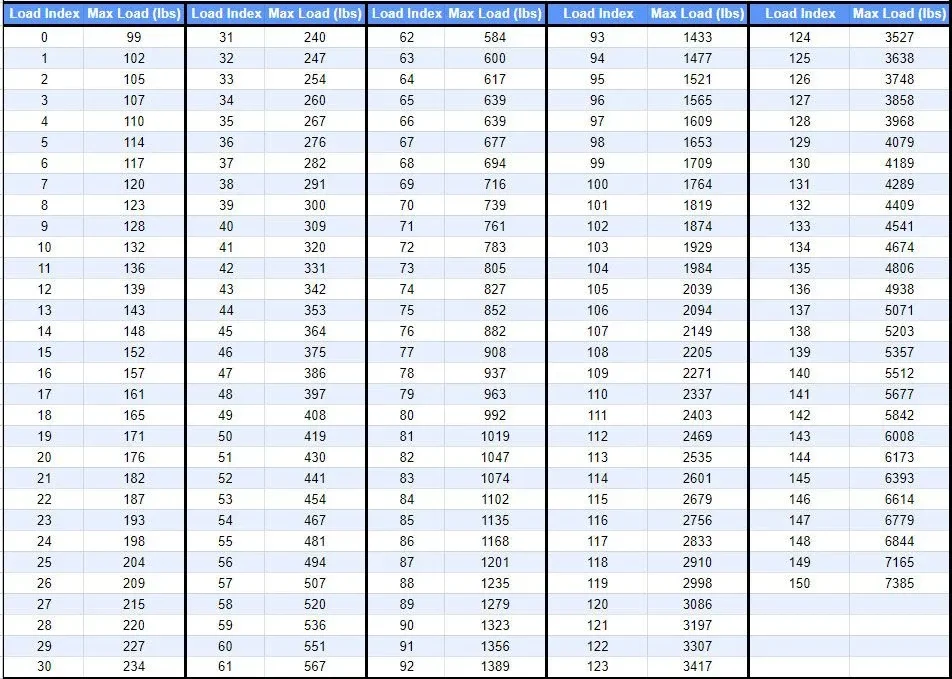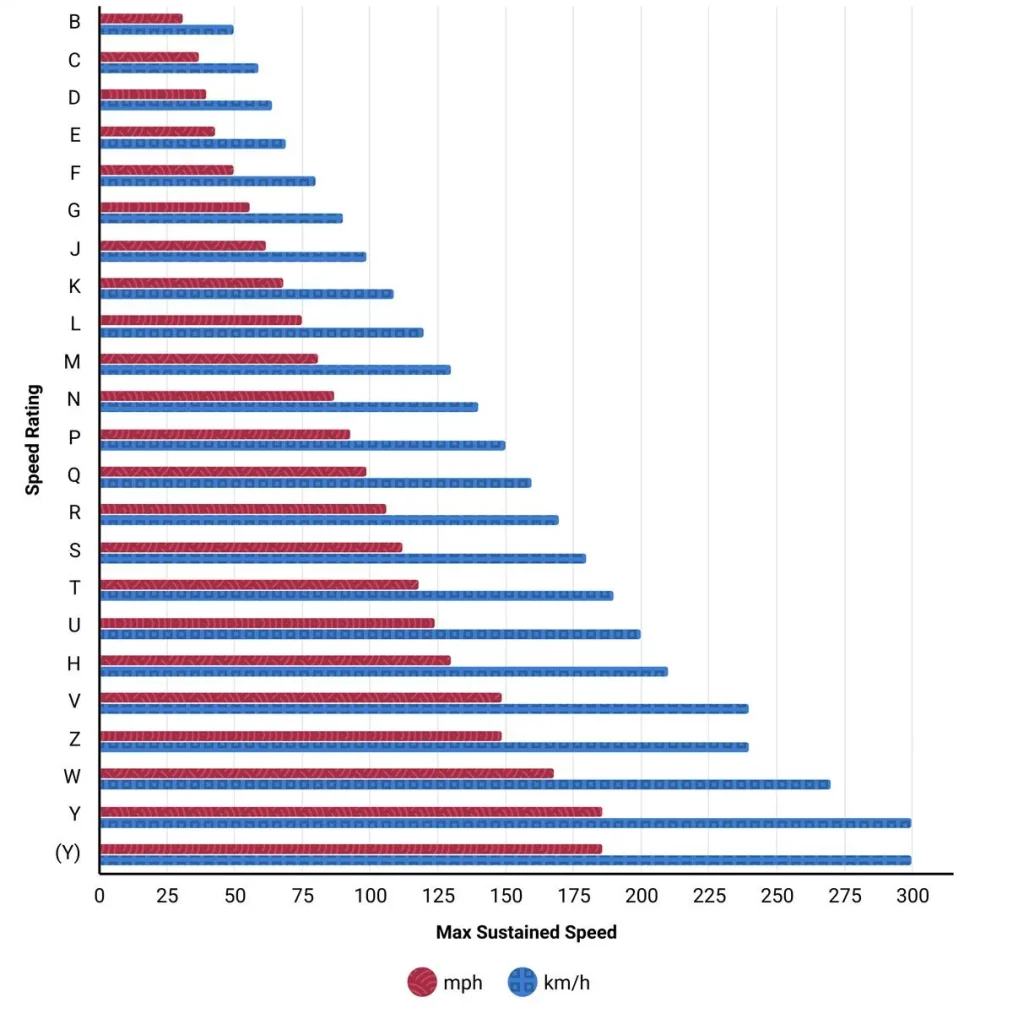Regarding vehicle safety and performance, the importance of selecting tires with the correct load index cannot be overstated. Overloading your tires is not just a minor oversight; it's a major safety hazard that can lead to catastrophic failures on the road. But what exactly is a tire load index, and why does it play such a pivotal role in your vehicle's overall health and functionality? The tire load index is a numerical code corresponding to the maximum weight a tire can safely support when properly inflated. This critical measurement ensures that your vehicle's tires can carry the combined weight of the vehicle, passengers, and any additional load without compromising safety or performance.
This article aims to demystify the concept of tire load index, providing drivers with the knowledge they need to make informed decisions about their tires. From understanding how to read and interpret load index values to recognizing the potential risks of ignoring these specifications, we aim to be your go-to resource for everything related to the tire load index. By the end of this guide, you'll appreciate the load index's significance in maintaining your vehicle's safety and efficiency and feel confident in selecting tires perfectly suited to your needs.
What is the Tire Load Index?

The tire load index is essential to tire specifications, providing crucial information about a tire's weight-bearing capacity. This index is a numerical value corresponding to the maximum load (weight) a tire can support when properly inflated. It's not just a random number but a key factor in ensuring your vehicle operates safely and efficiently.
The load index is part of the tire size designation on the sidewall. For instance, in a tire size marking “225/50R17 94V,” the “94” denotes the tire's load index. Each number in the load index corresponds to a specific weight capacity. The higher the number, the greater the tire's load-carrying capacity. This system allows drivers and professionals to select tires suitable for their vehicle's weight and any additional load they expect to carry, such as passengers and cargo.
To visualize this, imagine a tire load index chart that lists load index numbers alongside their corresponding weight capacities in pounds and kilograms. For example, a tire with a load index of 94 can safely support 1,477 pounds (670 kg) per tire. Four tires could support a vehicle and its contents up to 5,908 pounds (2,680 kg).
Understanding how load index translates to real-world tire use is crucial for vehicle safety and performance. For example, if you're driving a full-sized SUV packed with passengers and luggage for a road trip, selecting tires with an adequate load index is essential to accommodate the combined weight safely. Conversely, using tires with a load index too low for your vehicle's weight can lead to tire overloading, increasing the risk of tire failure, decreased handling, and potentially dangerous driving conditions.
By consulting a tire load index chart and knowing your vehicle's total weight, including passengers and cargo, you can ensure that your tires are fit for the task. This not only enhances safety but also optimizes your vehicle's handling and longevity of the tires, providing peace of mind on every journey.
Why Does Tire Load Index Matter?
The significance of the tire load index extends far beyond a mere number on your tire's sidewall; it is a critical factor affecting safety, performance, and legal compliance. Understanding and adhering to the recommended load index for your vehicle's tires is crucial for several reasons:
Safety Focus
Safety is the primary concern when ignoring the tire load index. Overloading tires beyond their rated capacity can lead to dangerous outcomes, including compromised handling and stability. Tires under excessive load are more prone to overheating, significantly increasing the risk of blowouts and tread separations. This risk is even greater at higher speeds. It's important to choose tires with a load index that accounts for the weight of your vehicle and a tire speed rating suitable for how you drive.
Such catastrophic tire failures at high speeds can result in loss of vehicle control, posing a serious risk to the vehicle's occupants and others on the road. Therefore, ensuring your tires have the correct load index is essential to maintain optimal driving safety conditions.
Performance
Beyond safety, the load index of a tire directly impacts vehicle performance. Tires with a mismatched load index can suffer from uneven wear and reduced lifespan due to the increased strain and heat buildup. This necessitates more frequent tire replacements and can lead to suboptimal handling characteristics. For instance, overburdened tires may exhibit poor responsiveness in steering, longer braking distances, and diminished fuel efficiency. Selecting the correct load index ensures that your tires can adequately support your vehicle's weight without compromising performance, providing a smoother and more efficient driving experience.
Compliance
Lastly, using tires with an inadequate load index can have legal implications. Many jurisdictions have specific vehicle safety and roadworthiness regulations, including matching tire load capacities to the vehicle's weight. Failure to comply with these regulations can result in penalties, fines, and even invalidate your insurance in the event of an accident. Furthermore, in the case of a collision, if it's found that the tires are not suitable for the vehicle's load, it could lead to liability issues and exacerbate legal consequences.
In summary, the tire load index is a crucial parameter that should always be considered when selecting tires for your vehicle. It ensures that your vehicle remains safe to drive under various conditions, optimizes performance and tire longevity, and keeps you compliant with road safety regulations. By prioritizing the correct load index, drivers can mitigate risks, enhance their driving experience, and avoid legal complications.
How to Find Your Tire's Load Index
Selecting the right tires for your vehicle involves understanding various specifications, including the tire load index. This figure is crucial for ensuring your tires can safely support your vehicle's weight. Here's how you can locate and interpret your tire's load index:
- Inspect the Tire Sidewall: Begin by examining the sidewall of your tire. You're looking for numbers and letters representing the tire's size and specifications. This is typically found in a format similar to “225/50R17 94V.”
- Identify the Load Index: Within this sequence, the load index is usually a two or three-digit number preceding the speed rating letter. In our example, “94V,” the number “94” is the load index.
- Check All Tires: Ensure you check all your tires. They should all have the same or compatible load indexes for safe and balanced vehicle performance.
Decoding the Load Index
The load index number corresponds to a specific weight capacity, indicating the maximum load (in pounds or kilograms) one tire can support when properly inflated. This number is not arbitrary; it's part of an international system that standardizes tire load capacities.
To interpret this number:
- Refer to a Load Index Chart Above: You will need to look at the load index shared with you above or reference another load chart you can find online. These charts list the load index numbers alongside the corresponding weight each tire can support.
- Find Your Number: Locate your tire's load index number on the chart to see the maximum load capacity. For example, a load index of 94 indicates that each tire can support up to 1,477 pounds (670 kg) under optimal conditions.
- Calculate Total Capacity: To understand your vehicle's total capacity, multiply the tire's load capacity by four (for a standard four-tire vehicle). This gives you the maximum weight your vehicle can safely carry, including passengers, cargo, and weight.
Understanding your tire's load index is crucial for safety and performance. It ensures that your tires can support your vehicle's weight, which is essential for preventing tire overloading, premature wear, and potential tire failure. Always choose tires with a load index that meets or exceeds the manufacturer's recommendations for your vehicle. This proactive approach ensures that your vehicle remains safe and efficient, regardless of its load.
Determining the Right Load Index for Your Vehicle
Choosing tires with the appropriate load index ensures your vehicle operates safely and efficiently under all conditions. Here's how to determine the right load index for your vehicle, considering vehicle specifications, driving habits, and the total load your tires need to support.
Vehicle Specifications
The first and most reliable source for determining the correct load index for your tires is your vehicle's owner's manual. Vehicle manufacturers provide specific tire specifications, including the minimum load index required to support the vehicle's maximum weight safely. This information is often found on a sticker inside the driver's side door jamb, detailing tire size and inflation pressure alongside the recommended load index. Always adhere to these recommendations to ensure your vehicle's safety and optimal performance.
Driving Habits
Consider your typical driving habits and how they might affect the load regularly placed on your tires. If you frequently haul heavy loads, tow trailers, or carry multiple passengers, your vehicle will require tires with a higher load index to safely support the additional weight. Choosing a tire with a load index higher than your vehicle manufacturer's recommendation can offer additional safety margin and durability under these conditions. However, it's important to note that while a higher load index can provide extra capacity for heavy loads, it should not be the sole factor in tire selection, as overall tire compatibility with your vehicle is essential.
Calculating Load
To ensure you select tires with the appropriate load index, you must understand the total weight they need to support. This includes the vehicle's curb weight (the weight of the vehicle with standard equipment and necessary operating consumables without passengers or cargo), the weight of all passengers, and the weight of any cargo you typically carry.
- Find Your Vehicle's Curb Weight: This information is usually in the owner's manual or a label inside the driver's side door frame.
- Estimate Passenger and Cargo Weight: Add the average weight of passengers and any cargo or equipment you regularly carry in your vehicle.
- Total Weight: Sum the curb weight with the estimated passenger and cargo weight to determine the combined weight your tires need to support.
Once you have the total weight, ensure that the load index of the tires you select meets or exceeds this weight. Remember that the load index reflects the capacity per tire, so the combined capacity of all your tires should comfortably support the total weight of your vehicle plus cargo and passengers.
You can select tires with the appropriate load index by carefully considering your vehicle's specifications, driving habits, and the total load your tires need to support. This not only ensures your safety on the road but also contributes to the longevity of your tires and the overall performance of your vehicle.
What's the Difference Between Load Index and Load Range?
The load index is a numerical code that specifies the maximum load a tire can carry at a specified inflation pressure. It's a standardized figure for passenger vehicles, including cars, SUVs, and light trucks, indicating a tire's load-carrying capacity.
Load range, however, is a rating that applies primarily to tires designed for heavier-duty applications, such as trucks and trailers. It indicates a tire's ply rating and ability to withstand different pressures and loads. Load range is identified by letters (e.g., B, C, D, E, F) and provides information on the tire's toughness and capacity to handle heavy loads and high inflation pressures.
While load index and load range communicate a tire's load-carrying capacity, they are used for different types of vehicles and tires. The load index is more commonly used for passenger vehicles, whereas the load range is typical for commercial, heavy-duty applications. Understanding the distinction between these two can help ensure you select the right tires for your vehicle, balancing safety, performance, and durability.
Tire Load Index: Bottom Line
The tire load index is a critical specification that directly impacts your vehicle's operation's safety, performance, and legality. It represents the maximum weight each tire can safely support when properly inflated, ensuring that your vehicle can carry a load of passengers, cargo, and itself without risking tire failure. Ignoring the tire load index can lead to overloading tires, which compromises handling, increases the risk of blowouts, accelerates tire wear, and can even result in legal and insurance complications.
Understanding and adhering to the recommended load index is not just about compliance; it's about ensuring your vehicle operates under the safest conditions possible. Overloading tires is a serious risk that can have dire consequences. It's essential to select tires that meet or exceed the manufacturer's specifications and consider your driving habits and the total weight your vehicle regularly carries.
As a vehicle owner, it's your responsibility to check the load index of your tires and ensure they are appropriate for your vehicle's requirements. If your current tires do not meet these standards or are nearing the end of their lifespan, consider this a call to action to seek replacements that do. Choosing the right tires with the correct load index is an investment in your vehicle's safety and longevity. Please take the time to review your tire specifications today and make informed decisions to keep your vehicle running safely and efficiently on every journey.
FAQs about Tire Load Index
Can I Use Tires with a Higher Load Index Than Recommended?
Yes, you can use tires with a higher load index than what is recommended by your vehicle's manufacturer. Doing so can offer additional load-carrying capacity, which might be beneficial if you frequently carry heavy loads or passengers. However, it's essential to ensure that the tires' other specifications, such as size and speed rating, are compatible with your vehicle. While a higher load index can provide a safety margin for carrying additional weight, it should stay consistent with the manufacturer's recommendations to maintain optimal vehicle performance and handling.
Does a Higher Load Index Always Mean a Stiffer Ride?
Not necessarily. While it's true that tires designed to carry heavier loads may have stiffer sidewalls, the ride quality is influenced by various factors, including tire construction, tread design, and the vehicle's suspension system. Modern tires with a higher load index are engineered to deliver the required load-carrying capacity and a comfortable ride. However, in some cases, especially when significantly exceeding the recommended load index, you may notice a slight difference in ride comfort due to the increased stiffness of the tire's construction.


